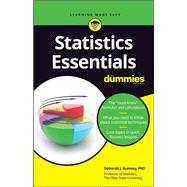Statistics Essentials For Dummies (9781119590309) was previously published as Statistics Essentials For Dummies (9780470618394). While this version features a new Dummies cover and design, the content is the same as the prior release and should not be considered a new or updated product.
Statistics Essentials For Dummies not only provides students enrolled in Statistics I with an excellent high-level overview of key concepts, but it also serves as a reference or refresher for students in upper-level statistics courses. Free of review and ramp-up material, Statistics Essentials For Dummies sticks to the point, with content focused on key course topics only. It provides discrete explanations of essential concepts taught in a typical first semester college-level statistics course, from odds and error margins to confidence intervals and conclusions. This guide is also a perfect reference for parents who need to review critical statistics concepts as they help high school students with homework assignments, as well as for adult learners headed back into the classroom who just need a refresher of the core concepts.
The Essentials For Dummies Series
Dummies is proud to present our new series, The Essentials For Dummies. Now students who are prepping for exams, preparing to study new material, or who just need a refresher can have a concise, easy-to-understand review guide that covers an entire course by concentrating solely on the most important concepts. From algebra and chemistry to grammar and Spanish, our expert authors focus on the skills students most need to succeed in a subject.








